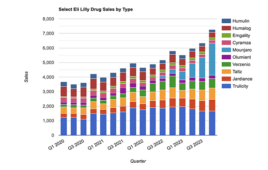Zogenix reported positive top-line results from its second confirmatory Phase 3 study (Study 1504) for its investigational drug, ZX008 (low-dose fenfluramine hydrochloride), for the treatment of children and young adults with Dravet syndrome.
The study results, which are consistent with those reported in Study 1, Zogenix’s first pivotal Phase 3 study, successfully met the primary endpoint and all key secondary endpoints, demonstrating that ZX008, at a dose of 0.5 mg/kg/day (maximum 20 mg/day), is superior to placebo when added to a stiripentol regimen.
Key Findings
- Patients taking ZX008 achieved a 54.7 percent greater reduction in mean monthly convulsive seizures compared to placebo (p<0.001). The median reduction in monthly convulsive seizure frequency was 62.7 percent in the ZX008 group compared to 1.2 percent in placebo patients.
- ZX008 also demonstrated statistically significant improvement versus placebo in both key secondary measures, including patients with clinically meaningful reductions (>50 percent) in seizure frequency and longest seizure-free interval.
- ZX008 was generally well-tolerated in this study with the adverse events consistent with those observed in Study 1 and the known safety profile of fenfluramine. No patient exhibited cardiac valvulopathy or pulmonary hypertension at any time in the study.
“These impressive study results show the significant impact the addition of ZX008 made in reducing the burden of convulsive seizures for patients who are not adequately controlled using stiripentol, the standard of care for the treatment of Dravet syndrome in Europe,” said Professor Rima Nabbout, M.D., Ph.D., department of pediatric neurology, Reference Center for Rare Epilepsies, Necker Enfants Malades Hospital, and principal investigator of Study 1504. “If approved, ZX008 has the potential to be a transformative treatment for Dravet syndrome, a rare and serious form of epilepsy with few available treatment options.”
Secondary endpoints assessed ZX008 compared to placebo in terms of the proportions of patients who achieved ≥50 percent reductions and ≥75 percent reductions in monthly convulsive seizures, as well as the median of the longest convulsive seizure-free interval.
“Patients with Dravet syndrome can often experience frequent, severe convulsive seizures that dramatically impact quality of life for them and their families,” said Linda Laux, M.D., associate professor, pediatrics – neurology, Ann & Robert H. Lurie Children’s Hospital of Chicago. “For patients who continue to have significant seizures and need new treatments to reduce seizure frequency and improve quality of life, ZX008 may be an exciting and important new treatment option.”
ZX008 was generally well-tolerated in this study, with the adverse events consistent with those observed in Study 1 and the known safety profile of fenfluramine. The incidence of treatment emergent adverse events was similar in both the treatment and placebo groups, with 97.7 percent (n=42) of patients receiving ZX008 experiencing at least one treatment emergent adverse event compared to 95.5 percent (n=42) of patients in the placebo group. The most common adverse events in the ZX008 group were decreased appetite, diarrhea, pyrexia, fatigue, and nasopharyngitis.
The incidence of serious adverse events was similar in both the treatment and placebo groups, with 14 percent (n=6) of patients in the ZX008 group experiencing at least one treatment emergent serious adverse event compared to 15.9 percent (n=7) of patients in the placebo group. Two patients in the ZX008 group had an adverse event leading to study discontinuation compared to one in the placebo group.
Prospective cardiac safety monitoring throughout the study did not identify clinical or echocardiographic evidence of cardiac valvulopathy or pulmonary hypertension in any patient. This confirms the observations from Study 1 which also reported no valvulopathy or pulmonary hypertension in any patient.
Furthermore, approximately 300 patients are currently enrolled in the ongoing open-label safety extension study (Study 1503), some of whom have been treated with ZX008 on a daily basis for over two years. In all studies, no safety signal of any cardiovascular abnormality has been identified to date.
The double blind, placebo controlled, Phase 3 study (Study 1504) randomized 87 patients, with a median age of 9 years (range, 2-19 years), across sites in Europe, the United States, and Canada. Following a six-week baseline observation period, patients were assigned to one of two treatment groups in which ZX008 (n=43) or placebo (n=44) was added to their stable background regimen of stiripentol plus other antiepileptic drugs.
The ZX008 dose of 0.5 mg/kg/day (20 mg maximum daily dose) in this study accounted for a drug-drug interaction between stiripentol and ZX008 and was designed to approximate the 0.8 mg/kg/day dose evaluated in Study 1 where stiripentol use was not permitted. The mean baseline convulsive seizure frequency across all treatment groups in Study 1504 was approximately 25 seizures per month. Patients were titrated to their target dose over three weeks and then remained at that fixed dose for 12 weeks.
ZX008 is designated as an orphan drug in both the U.S. and Europe, and has received Breakthrough Therapy designation in the U.S. for the treatment of Dravet syndrome.
Earlier this year, Zogenix conducted a positive meeting with the U.S. FDA regarding the ZX008 clinical development program and planned New Drug Application (NDA) submission in Dravet syndrome in which FDA affirmed Study 1 and Study 1504 were suitable as the clinical basis for the NDA submission.
(Source: Zogenix, Inc.)
Filed Under: Drug Discovery




